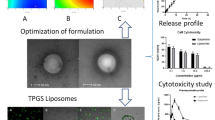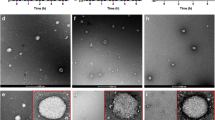Abstract
Numerous studies have recently shown that vitamin K2 (VK2) has antitumor effects in a variety of tumor cells, but there are few reports demonstrating antitumor effects of VK2 in vivo. The antitumor effects of VK2 in nanoemulsions are currently not known. Therefore, we sought to characterize the antitumor potential of VK2 nanoemulsions in S180 tumor cells in the present study. Furthermore, a ligand conjugate sialic acid–cholesterol, with enhanced affinity towards the membrane receptors overexpressed in tumors, was anchored on the surface of the nanoemulsions to increase VK2 distribution to the tumor tissue. VK2 was encapsulated in oil-in-water nanoemulsions, and the physical and chemical stability of the nanoemulsions were characterized during storage at 25 °C. At 25 °C, all nanoemulsions remained physically and chemically stable with little change in particle size. An in vivo study using syngeneic mice with subcutaneously established S180 tumors demonstrated that intravenous or intragastric administration of VK2 nanoemulsions significantly suppressed the tumor growth. The VK2 nanoemulsions modified with sialic acid–cholesterol conjugate showed higher tumor growth suppression than the VK2 nanoemulsions, while neither of them exhibited signs of drug toxicity. In summary, VK2 exerted effective antitumor effects in vivo, and VK2 nanoemulsions modified with sialic acid–cholesterol conjugate enhanced the antitumor activity, suggesting that these VK2 may be promising agents for the prevention or treatment of tumor in patients.








Similar content being viewed by others
References
Dam H. The antihæmorrhagic vitamin of the chick.: occurrence and chemical nature. Biochem J. 1935;29(6):1273–85.
Shearer MJ, Vitamin K. Lancet. 1995;345(8944):229–34.
Mahdinia E, Demirci A, Berenjian A. Production and application of menaquinone-7 (vitamin K2): a new perspective. World J Microbiol Biotechnol. 2017;33(1):2.
Buchanan MDGS, Melvin T, et al. Vitamin K2 (menaquinone) supplementation and its benefits in cardiovascular disease osteoporosis, and cancer. Marshall J Med. 2016;2(3):53.
Tsukamoto Y, Ichise H, Kakuda H, Yamaguchi M. Intake of fermented soybean ( natto ) increases circulating vitamin K 2 (menaquinone-7) and γ-carboxylated osteocalcin concentration in normal individuals. J Bone Miner Metab. 2000;18(4):216–22.
Gast GCM, Roos NMD, Sluijs I, Bots ML, Beulens JWJ, Geleijnse JM, et al. A high menaquinone intake reduces the incidence of coronary heart disease. Nutr Metab Cardiovasc Dis. 2009;19(7):504–10.
O’Neil M. The Merck index. Merck & Co; 1989.
Collins MDJD. Distribution of isoprenoid quinone structural types in bacteria and their taxonomic implication. Microbiol Rev. 1981;45(2):316–54.
Nelsestuen GL, Zytkovicz TH, Howard JB. The mode of action of vitamin K identification of γ-carboxyglutamic acid as a component of prothrombin. J Biol Chem. 1974;249(19):6347.
Villa JK, Diaz MA, Pizziolo VR, Martino HS. Effect of vitamin K in bone metabolism and vascular calcification: a review of mechanisms of action and evidences. Crit Rev Food Sci Nutr. 2016. https://doi.org/10.1080/10408398.2016.1211616
Shea MK, Kritchevsky SB, Hsu FC, Nevitt M, Booth SL, Kwoh CK, et al. The association between vitamin K status and knee osteoarthritis features in older adults: the Health, Aging and Body Composition Study. Osteoarthr Cart. 2015;23(3):370–8.
Ferland G. Vitamin K and the nervous system: an overview of its actions. Adv Nutr. 2012;3(2):204–12.
Allison AC. The possible role of vitamin K deficiency in the pathogenesis of Alzheimer’s disease and in augmenting brain damage associated with cardiovascular disease. Med Hypotheses. 2001;57(2):151–5.
Vos M, Esposito G, Edirisinghe JN, Vilain S, Haddad DM, Slabbaert JR, et al. Vitamin K2 is a mitochondrial electron carrier that rescues pink1 deficiency. Science. 2012;336(6086):1306.
Azuma KIS. Aging mechanisms. Vitamin K benefits in aging and cancer. Japan: Springer; 2015.
Li L, Qi Z, Qian J, Bi F, Lv J, Xu L, et al. Induction of apoptosis in hepatocellular carcinoma Smmc-7721 cells by vitamin K(2) is associated with p53 and independent of the intrinsic apoptotic pathway. Mol Cell Biochem. 2010;342(1):125–31.
Otsuka M, Kato N, Shao RX, Hoshida Y, Ijichi H, Koike Y, et al. Vitamin K2 inhibits the growth and invasiveness of hepatocellular carcinoma cells via protein kinase A activation. Hepatology. 2004;40(1):243–51.
Yoshida T, Miyazawa K, Kasuga I, Yokoyama T, Minemura K, Ustumi K, et al. Apoptosis induction of vitamin K2 in lung carcinoma cell lines: the possibility of vitamin K2 therapy for lung cancer. Int J Oncol. 2003;23(3):627.
Yokoyama T, Miyazawa K, Yoshida T, Ohyashiki K. Combination of vitamin K2 plus imatinib mesylate enhances induction of apoptosis in small cell lung cancer cell lines. Int J Oncol 2005;26(1):33–40.
Kawakita H, Tsuchida A, Miyazawa K, Naito M, Shigoka M, Kyo B, et al. Growth inhibitory effects of vitamin K2 on colon cancer cell lines via different types of cell death including autophagy and apoptosis. Int J Mol Med. 2009;23(6):709–16.
Tokita H, Tsuchida A, Miyazawa K, Ohyashiki K, Katayanagi S, Sudo H, et al. Vitamin K2-induced antitumor effects via cell-cycle arrest and apoptosis in gastric cancer cell lines. Int J Mol Med. 2006;17(2):235–43.
Kiely M, Hodgins SJ, Merrigan BA, Tormey S, Kiely PA, O'Connor EM. Real-time cell analysis of the inhibitory effect of vitamin K2 on adhesion and proliferation of breast cancer cells. Nutr Res. 2015;35(8):736.
Duan F, Yu Y, Guan R, Xu Z, Liang H, Hong L. Vitamin K2 induces mitochondria-related apoptosis in human bladder cancer cells via ROS and JNK/p38 MAPK signal pathways. PLoS One. 2016;11(8):e0161886.
Yue X, Akahira JI, Utsunomiya H, Miki Y, Takahashi N, Niikura H, et al. Steroid and xenobiotic receptor (SXR) as a possible prognostic marker in epithelial ovarian cancer. Pathol Int. 2010;60(5):400–6.
Lamson DW, Plaza SM. The anticancer effects of vitamin K. Altern Med Rev J Clin Ther. 2003;8(3):303.
Nutter LM, Cheng AL, Hung HL, Hsieh RK, Ngo EO, Liu TW. Menadione: spectrum of anticancer activity and effects on nucleotide metabolism in human neoplastic cell lines. Biochem Pharmacol. 1991;41(9):1283–92.
Kitagawa J, Hara T, Tsurumi H, Ninomiya S, Ogawa K, Adachi S, et al. Synergistic growth inhibition in HL-60 cells by the combination of acyclic retinoid and vitamin K2. J Cancer Res Clin Oncol. 2011;137(5):779–87.
Russo I, Caroppo F, Alaibac M. Vitamins and melanoma. Cancers. 2015;7(3):1371–87.
Zhang H, Ozaki I, Hamajima H, Iwane S, Takahashi H, Kawaguchi Y, et al. Vitamin K2 augments 5-fluorouracil-induced growth inhibition of human hepatocellular carcinoma cells by inhibiting NF-κB activation. Oncol Rep. 2011;25(1):159–66.
Samykutty A, Shetty AV, Dakshinamoorthy G, Kalyanasundaram R, Zheng G, Chen A, et al. Vitamin k2, a naturally occurring menaquinone, exerts therapeutic effects on both hormone-dependent and hormone-independent prostate cancer cells. Evid Based Complement Alternat Med eCAM. 2013;2013(6):287358.
Yoshiji H, Kuriyama S, Noguchi R, Yoshii J, Ikenaka Y, Yanase K, et al. Combination of vitamin K2 and the angiotensin-converting enzyme inhibitor, perindopril, attenuates the liver enzyme-altered preneoplastic lesions in rats via angiogenesis suppression. J Hepatol. 2005;42(5):687–93.
Yao Y, Li L, Zhang H, Jia R, Liu B, Zhao X, et al. Enhanced therapeutic efficacy of vitamin K2 by silencing BCL-2 expression in SMMC-7721 hepatocellular carcinoma cells. Oncol Lett. 2012;4(1):163–7.
Xia J, Matsuhashi S, Hamajima H, Iwane S, Takahashi H, Eguchi Y, et al. The role of PKC isoforms in the inhibition of NF-κB activation by vitamin K2 in human hepatocellular carcinoma cells. J Nutr Biochem. 2012;23(12):1668–75.
Ogawa M, Nakai S, Deguchi A, Nonomura T, Masaki T, Uchida N, et al. Vitamins K2, K3 and K5 exert antitumor effects on established colorectal cancer in mice by inducing apoptotic death of tumor cells. Int J Oncol. 2007;31(2):323.
Habu D, Shiomi S, Tamori A, Takeda T, Tanaka T, Kubo S, et al. Role of vitamin K2 in the development of hepatocellular carcinoma in women with viral cirrhosis of the liver. JAMA. 2004;292(3):358–61.
Schurgers LJ, Vermeer C. Differential lipoprotein transport pathways of K-vitamins in healthy subjects. Biochim Biophys Acta. 2002;1570(1):27–32.
Rapoport N, Nam KH, Gupta R, Gao Z, Mohan P, Payne A, et al. Ultrasound-mediated tumor imaging and nanotherapy using drug loaded, block copolymer stabilized perfluorocarbon nanoemulsions. J Control Release. 2011;153(1):4.
Meng Y, Zou C, Madiyalakan R, Woo T, Huang M, Yang X, et al. Water-soluble and biocompatible sono/photosensitizer nanoparticles for enhanced cancer therapy. Nanomedicine. 2017;5(10):1559–69.
Zheng JS, Zheng SY, Zhang YB, Yu B, Zheng W, Yang F, et al. Sialic acid surface decoration enhances cellular uptake and apoptosis-inducing activity of selenium nanoparticles. Colloids Surf B Biointerfaces. 2011;83(1):183.
She Z, Zhang T, Wang X, Li X, Song Y, Cheng X, et al. The anticancer efficacy of pixantrone-loaded liposomes decorated with sialic acid–octadecylamine conjugate. Biomaterials. 2014;35(19):5216–25.
Zhou S, Zhang T, Bo P, Xiang L, Liu X, Ling H, et al. Targeted delivery of epirubicin to tumor-associated macrophages by sialic acid-cholesterol conjugate modified liposomes with improved antitumor activity. Int J Pharm. 2017;523(1):203–16.
Liu Y, Huang L, Liu F. Paclitaxel nanocrystals for overcoming multidrug resistance in cancer. Mol Pharm. 2010;7(3):863.
Nakamura H, Fang J, Maeda H. Development of next-generation macromolecular drugs based on the EPR effect: challenges and pitfalls. Expert Opin Drug Deliv. 2014;12(4):1–12.
Whiteside TL, editor. Immune suppression in cancer: effects on immune cells, mechanisms and future therapeutic intervention. Seminars in cancer biology. Elsevier; 2006.
Couzin-Frankel J. Cancer immunotherapy. Science. 2013;342(6165):1432–3.
D DW. Studies correlating the growth rate of a tumor and its metastases and providing evidence for tumor-related systemic growth-retarding factors. Cancer Res. 1972;32(2):374–9.
Roth H, Kitta D, Jones GRN, Osswald H, Kunz W. Polyamine responses in a solid transplanted tumor (S180) in liver and in urine during endotoxin-induced tumor injury in the mouse. Cancer. 1981;48(4):945.
Sjövall K, Nilsson B, Einhorn N. Different types of rupture of the tumor capsule and the impact on survival in early ovarian carcinoma. Int J Gynecol Cancer. 2010;4(5):333–6.
Nath D, Hartnell A, Happerfield L, Miles DW, Burchell J, Taylorpapadimitriou J, et al. Macrophage-tumour cell interactions: identification of MUC1 on breast cancer cells as a potential counter-receptor for the macrophage-restricted receptor, sialoadhesin. Immunology. 1999;98(2):213–9.
Jing S, Song Y, Mei L, Lin X, Yang L, Zhou S, et al. Evaluation of the antitumor effect of dexamethasone palmitate and doxorubicin co-loaded liposomes modified with a sialic acid–octadecylamine conjugate. Eur J Pharm Sci. 2016;93:177–83.
Hong W, Chen D, Zhang X, Zeng J, Hu H, Zhao X, et al. Reversing multidrug resistance by intracellular delivery of Pluronic® P85 unimers. Biomaterials. 2013;34(37):9602–14.
Acknowledgements
This study was supported by the National Natural Science Foundation of China (81373334).
Author information
Authors and Affiliations
Corresponding authors
Ethics declarations
Animal studies were performed in accordance with the Guidelines for Animal Experimentation of Shenyang Pharmaceutical University and approved by the Animal Ethics Committee of the institution.
Rights and permissions
About this article
Cite this article
Shi, J., Zhou, S., Kang, L. et al. Evaluation of the antitumor effects of vitamin K2 (menaquinone-7) nanoemulsions modified with sialic acid-cholesterol conjugate. Drug Deliv. and Transl. Res. 8, 1–11 (2018). https://doi.org/10.1007/s13346-017-0424-1
Published:
Issue Date:
DOI: https://doi.org/10.1007/s13346-017-0424-1




